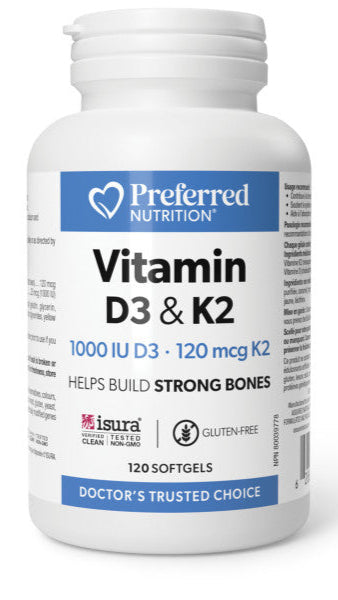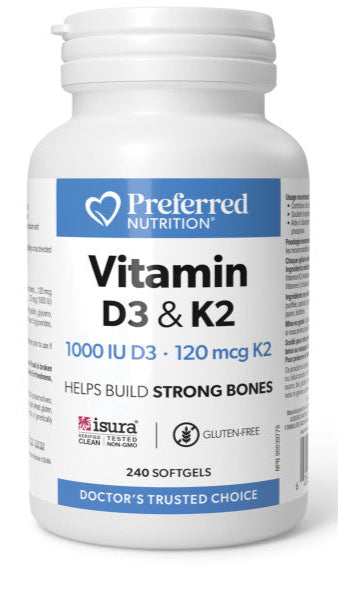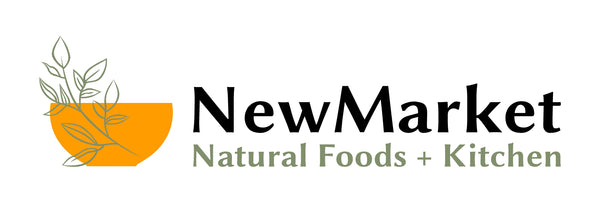Vitamin D3 & K2
Vitamin D3 & K2
Helps Build Strong Bones
Preferred Nutrition Vitamin D3 & K2 combines the biologically active MK-7 form of vitamin K2 with active vitamin D3 (as cholecalciferol) to help build strong bones and teeth while supporting immune function. Each daily softgel provides 120 mcg of vitamin K2 derived naturally from natto beans, along with 1000 IU of vitamin D3.
Benefits
-
Helps build strong bones and teeth
- Helps support immune function
- Helps in the absorption and use of calcium and phosphorus
- Contains 120 mcg of the bioavailable MK-7 form of vitamin K2 per softgel
- Provides 1000 IU of bioavailable vitamin D3 per softgel
Recommended adult dose: 1 softgel daily or as directed by a health care practitioner.
| Each softgel contains: | |
| Medicinal ingredients: | |
| Vitamin K2 (menaquinone 7) MK-7 (natto bean) | 120 mcg |
| Vitamin D (cholecalciferol) | 25 mcg (1000 IU) |
Non-medicinal Ingredients: Softgel (gelatin, glycerin, purified water, caramel), medium chain triglycerides, yellow beeswax, lecithin.
This product does not contain artificial preservatives, colours, or sweeteners; no dairy, starch, sugar, wheat, gluten, yeast, egg, fish, shellfish, salt, tree nuts, or genetically modified genes or proteins.
Vitamins K2 and D3 are essential for strong bones, working together to reduce bone loss and fracture risk as we age. Ensuring adequate intake of these fat-soluble vitamins and calcium is vital for long-term bone health (Kuang et al., 2020).
Vitamin D enhances the absorption of calcium and phosphorus in the intestine. In turn, vitamin K2 helps integrate calcium into the bones, where needed, and away from vascular and soft tissues where it may be damaging (Kuang et al., 2020; Mandatori et al., 2021). Vitamins K and D also promote gene activity in bone-building cells and activate an enzyme essential for bone formation (Kuang et al., 2020).
Vitamin K comes in two main forms: K1, found in leafy greens, herbs, and some plant oils, and K2, made by intestinal bacteria and found in fermented foods and animal products (Kuang et al., 2020). Studies show that only 10–15% of dietary K1 and minimal K2 from the gut are absorbed, leaving the body’s physiological needs unmet (Akbulut et al., 2020; Mandatori et al., 2021). The MK-7 form of vitamin K2 is found naturally in fermented natto beans and is much easier for the body to absorb than the MK-4 form (Sato et al., 2020).
Like vitamin K, vitamin D exists in different forms. Vitamin D3 (cholecalciferol), produced in the skin from sunlight exposure, is considered more biologically active than D2 (ergocalciferol). Clinical studies show that D3 supplements raise blood vitamin D levels 40% higher than D2 forms (Kuang et al., 2020; van den Heuvel et al., 2024).
Studies suggest that supplementing with vitamins K2 and D3 together provides enhanced benefits because of their complementary roles in the body. A meta-analysis of randomized, controlled trials involving 971 study participants showed a significant increase in the bone mineral density of participants who took vitamin K and D together compared to controls. Supplementation with both vitamins led to a decrease inundercarboxylated osteocalcin, a sign of active bone mineralization and improved strength. The positive effect on bones was especially strong when participants took vitamin K in its active K2 form (Kuang et al., 2020).
Several clinical studies have documented the bone-building benefits of vitamin K2. A meta-analysis of five studies involving a total of 80,982 participants identified a strong inverse relationship between vitamin K intake and bone fractures. Participants with the highest vitamin K intake had a 22% lower risk of fractures compared to those with the lowest intake. Furthermore, for each additional 50 mcg of vitamin K consumed each day, the risk of fracture decreased by 3% (Hao et al., 2017).
Vitamin D also supports immune function. A study involving military personnel during basic training found that participants with adequate vitamin D levels were 40% less likely to develop upper respiratory tract infections (URTIs) than participants with low vitamin D levels. Furthermore, daily supplementation with 1000 IU of vitamin D3 for four weeks, followed by 400 IU for eight weeks, reduced the severity of peak URTI symptoms in participants by 15% and the number of days with URTI by 36% (Harrison et al., 2021).




